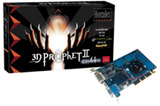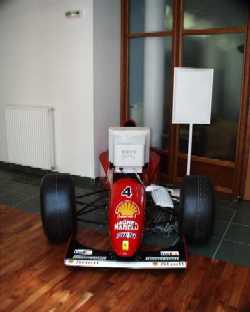
Page 4
Game pads
3D Prophet II GTS 64mb DDR DVIThere are two new game pads which may provide a more portable alternative to a traditional stick controller for times that you just have to play that sim while on the road. The Dual Analog game pad has dual mini joysticks, a coolie hat, and 13 buttons for approximately $29.95. The Dual power adds force feedback motors to each 'wing' of the game pad for approximately $39.95.
At the end of the day I met Francois Garet, Hardware Project manager. When he walked into the room with a small package in his hands I new I was in for a treat. He removed the new 3D Prophet II GTS 64mb from the static baggie and placed it on the table. The first thing I noticed was the heat sinks on the RAM and processor. The GPU has a fan to boot. Manufacturers are notoriously quiet about overclockability and far be it from me to suggest you overclock your video board
Fig. 6. 3D Prophet II 64mb. The new 64mb board is physically smaller than the 32mb board (go figure). Francois told me that it was very close to the nVidia reference design. The much larger Prophet II 32mb board was not. The card includes the usual RGB out for a CRT monitor, a DVI out for a LCD or a digital CRT monitor, and a S video out connection. The S video can be configured in software to produce either S or composite output and there is an adapter included to provide a composite plug (RCA style) from the S jack. Guillemot will be releasing a utility to allow simultaneous output from the RGB and S video jack. This is not a dual head. However, it will permit connecting the S output to a LCD projector for presentations while a technician still has a monitor connected.
This is the fastest GTS board that I have heard of to date. Francois told me that it is clocked at 220mHz core and 366mHz DDR RAM. The first shipment of boards out the door will be shipped at this clock speed. The next batch will have the speeds reduced to the nVidia standard 200mHz core and 333mHz DDR RAM but no changes are being made to the card.
We talked about the board design and particularly the heat sinks on the RAM. Francois said that they were not added to facilitate any warranty busting tweaking but to improve reliability. Specifically he said the heat sink take heat away from the board. With the addition of 64mb of RAM and the potential for 128mb of RAM, the board generates a lot of heat. The chips can take it but the phenolic boards are really starting to take a blistering from the blistering speeds of the new graphic cards.
Thank you GuillemotFinally, we talked at length about the card's features including FSAA. During our conversation I had a revelation about nVidia's FSAA implementation. I have tested my insight briefly at 2:00am (adrenaline was flowing) and will include the details in my First Look at the Prophet II out next week. Let me tempt you by saying that the reports that nVidia's FSAA doesn't work are in error. It works like a charm once you understand how to optimize it.
I would like to thank Peter "McLane" Kreft, Martin Vargas, Francois Garet, Shannon Roussy Scott, and all the Guillemot staff for all the time they spent with me. It was a great first impression that I will keep for a long time.
Fig. 7. Toys for boys



